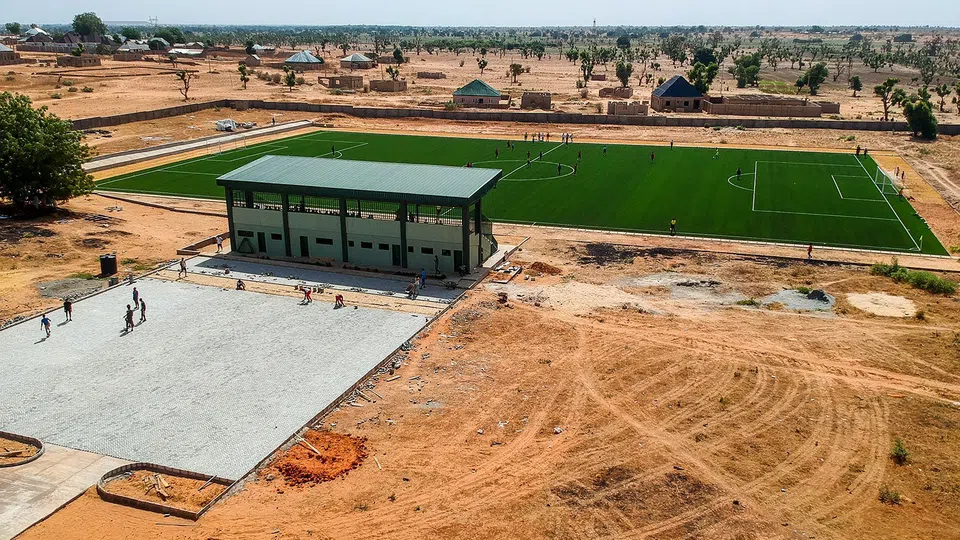In a week that sharpened conversations around transparency, priorities, and the soul of the game, Nigerian Football Governance and Developments became the thread connecting two very different headlines. On one side, the Nigeria Football Federation faced a social media storm over the Birnin Kebbi facility, on the other, Lagos State Football Association chairman Hajji Gafar Liameed was celebrated for driving grassroots excellence. Together, they paint a vivid picture of the tensions and triumphs shaping football in Nigeria today.
Kebbi project scrutiny and the bigger picture
The Birnin Kebbi Stadium project found itself at the center of heated public debate as images of the facility circulated online, prompting questions about design, cost, and the intended purpose of the build. Some critics compared the site unfavorably to Kenya’s ongoing 60,000 capacity stadium being prepared for the 2027 Africa Cup of Nations, a comparison that the NFF leadership has called misleading due to the entirely different objectives of the two projects.
NFF president Alhaji Ibrahim Musa Gusau defended the integrity of the initiative, explaining that the facility was conceived as a development level project under the FIFA Forward Programme, not as a tournament standard venue. According to Gusau, FIFA designed, approved, and monitored the work, with officials inspecting stages of construction and certifying that the build met expectations for its purpose. He also pushed back against what he described as politically motivated commentary, urging that scrutiny be grounded in facts rather than assumptions.
What FIFA oversight means for Nigeria
The federation’s defense of the Kebbi project has rested on oversight and audit, principles that were underscored by Amaju Pinnick in an interview with ARISE NEWS. Pinnick emphasized that when FIFA funding is involved, the money is tracked comprehensively, from allocation to execution, with standards that make irregularities difficult. He cited a contract value of about 1.1 million dollars in 2020, which he said was less than 400 million naira at the time, and noted there was no variation to the project even in the disruptions caused by COVID.
These assurances speak directly to public concern about how projects are conceived and measured. In this case, the Kebbi facility was presented as a developmental asset, a smaller scale infrastructure intended to expand access and raise the floor for training and competition. Gusau framed the effort as a step toward growth in northern Nigeria, where improved pitches and training environments can have outsized impact on participation and pathways. That focus on access and opportunity, he argued, is aligned with FIFA’s development objectives.
Clarity from lawmakers on how FIFA funds work
The public conversation drew an important clarification from the National Assembly. Kabiru Amadu, Chairman of the House Committee on Sports, explained that FIFA does not build standard national stadiums for any country. Instead, FIFA provides a football development grant, and national bodies choose projects that fit their growth plans, whether mini stadiums, coach education, or player development programs.
This distinction is central to the Kebbi debate. As Amadu put it, the grant structure means the NFF can decide to invest in a site like Birnin Kebbi as part of a broader development plan, or in technical programs designed to raise coaching standards. His comments reinforced the position that the Kebbi facility, associated with the Goal Project scheme, was never intended to rival a continental tournament venue. In other words, the appropriate yardstick is whether the project advances football development, not whether it meets AFCON hosting specifications.
Documents and public confidence
Seeking to steady the narrative, the NFF released documents that it says detail the scope of FIFA’s oversight on the project. The move aimed to counter misinformation that had gathered pace online and to restore confidence in how global development funds are used domestically. Communication of this kind matters, because transparency is not only about clean books, it is also about a clear explanation of purpose, design, and expected outcomes.
Gusau’s point that every dollar was accounted for highlights the broader trust equation. Audits and inspections can ensure compliance, yet public understanding depends on context, from the choice of location to the scale of the facility, and from timelines to the definition of success. By situating Birnin Kebbi within a development continuum, the federation has attempted to show that the project’s value lies in expanding reach and improving daily football life, especially in areas that previously lacked standard pitches or training spaces. That is where a development-level facility can be a difference maker.
Lagos State leadership earns recognition
While debates raged in Kebbi, Lagos had cause for celebration. Hajji Gafar Liameed, Chairman of the Lagos State Football Association, was named Best FA Chairman in Football Development at the 2025 Nigerian Soccer Ambassador Awards. The recognition, conferred by Ambassador Moses Ebahor, followed years of work to strengthen the grassroots ladder and support local clubs and youth pathways.
Under Liameed’s guidance, the Lagos State FA has pushed initiatives that include coaching clinics, training for referees, and youth tournaments. The city’s football scene has long been a crucible of talent, and the recent progress has helped more players make an impact on the national stage and in international competition. In his acceptance message, Liameed expressed gratitude and dedicated the honor to the people of Lagos State, the wider Nigerian football community, and his team, pledging to keep pushing for football development and excellence.
Two stories, one theme
At first glance, an awards night in Lagos and a controversy in Kebbi might seem unrelated. In reality, both are chapters in a single national story about how Nigeria grows its game. The first asks whether the country can build development infrastructure that is fit for purpose and fully accountable. The second shows what happens when leadership at the state level leans into structure, education, and consistent opportunities for young players and officials.
When critics invoke shiny tournament-ready stadiums elsewhere, it is an understandable emotional comparison. Big arenas capture imagination and signal ambition. Yet the scaffolding of a healthy football culture is often more modest, more distributed, and more focused on the daily environments where players train and compete. That is where governance, funding choices, and execution play decisive roles, and that is where measurable progress can either accelerate or stall.
The role of communication in public trust
Communication shapes perception, and perception shapes patience. The NFF’s decision to publish oversight documents represented an attempt to shift the conversation from speculation to verification. In practical terms, it invited the public to assess whether the process matched the promises of the FIFA Forward Programme and the Goal Project framework. If that transparency becomes standard practice, it can set a baseline for how infrastructure is discussed and judged.
For many fans, the question is not whether development facilities are worthwhile, it is whether each naira and dollar translates into access, quality, and continuity. That is where clarity about budgets, audits, and scope matters, and where updates on progress can help. The Kebbi debate, vigorous as it is, could well become a template for better dialogue, provided that stakeholders continue to supply information and remain open to factual scrutiny, a point both Gusau and Pinnick have emphasized from different platforms.
Grassroots value in Lagos and beyond
Liameed’s recognition underscores how steady investment in people can complement bricks and mortar. Coaching clinics lift knowledge, referee training elevates match quality, and youth tournaments generate competitive minutes that shape future professionals. These are the multipliers that take a football culture from promising to prolific.
The Lagos example also resonates nationally. As state FAs strengthen their programs, the pipeline to national teams becomes more reliable, and local clubs benefit from improved standards. Awards do not build stadiums, but they do validate strategies that can be replicated elsewhere. In that sense, the Lagos story offers a practical counterbalance to the Kebbi discourse, reminding stakeholders that development outcomes are achieved in many forms, not only in concrete and steel.
Why this debate matters for Nigerian football
Nigeria’s football future is shaped by decisions made in procurement rooms and on practice pitches alike. When a project like Birnin Kebbi faces scrutiny, it tests systems, reveals communication gaps, and challenges leaders to make their case. When a leader like Liameed is honored, it validates frameworks that nurture talent and strengthen the ecosystem from the bottom up.
Both dynamics are necessary. The country needs facilities that match local needs and budgets, and it needs programming that teaches, certifies, and inspires. If oversight and audits ensure that money is spent well, success stories in Lagos show how that money can convert into better football experiences for players, coaches, and referees. The connection between the two is where Nigeria can find sustainable momentum in football governance.
Key takeaways
- FIFA funding for Nigeria is tied to development goals, with audits and inspections that track spending,
- the Birnin Kebbi facility was conceived as a development project, not a tournament stadium,
- Lagos FA leadership under Hajji Gafar Liameed earned national recognition for grassroots progress.
What to watch next
As the NFF maintains that the Kebbi project is transparent, auditable, and aligned with FIFA’s mission to grow the game in emerging markets, the test will be in continued disclosure and delivery. The federation has already put forward documents to demonstrate oversight, a step that can be built upon with regular updates on timelines, functionality, and community impact.
In Lagos, the focus will remain on strengthening the base, from coaching to officiating to youth competition. Recognition can be a catalyst for more collaboration and investment, especially if success is documented and shared. Taken together, these tracks show how Nigerian football can reconcile controversy with progress, provided that leaders keep inviting scrutiny, and that achievements at the grassroots continue to set the pace for national development.
Final thought
The debate around Birnin Kebbi asks hard questions, while the celebration of Lagos offers clear answers. If governance is about choices, then choosing development with transparency is the path that connects both stories. In that connection lies a more resilient future for the game across Nigeria, from the northern pitches that need upgrades to the urban academies that sharpen talent, and from boardroom decisions to the cheers of fans who simply want football that they can trust and enjoy.






